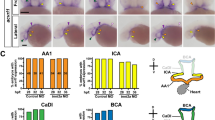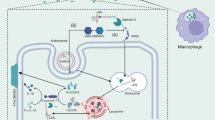Abstract
We have demonstrated previously that the Rho family GTPase Rac-1 is required for maintenance of endothelial barrier functions in mouse microvascular myocardial endothelial (MyEnd) cells in vitro as well as in rat mesenteric microvessels in vivo. In this study, we tested the hypothesis that specific activation of Rac-1 would stabilize microvascular endothelial barrier functions. For this purpose we used Escherichia coli Cytotoxic necrotizing factor (CNF-1) under conditions (300 ng/ml, 120 min) where it strongly activated Rac-1 and Cdc42 but not Rho A in MyEnd cells. Under these conditions, CNF-1 induced translocation of the actin-binding proteins cortactin and vasodilator-stimulated phosphoprotein (VASP) to cell junctions, increased the junction-associated actin filament belt, and reduced monolayer permeability. We also tested the effect of CNF-1 on endothelial barrier properties in vivo using single-perfused mesenteric microvessels. In contrast to cultured microvascular monolayers, CNF-1 did not reduce baseline barrier functions assayed as hydraulic conductivity (Lp). However, following 120 min pretreatment, CNF-1 significantly attenuated the peak Lp increase in response to platelet-activating factor (PAF, 10 nM) to 12.6±4×10−7 cm/(s cmH2O) compared to 46.2±10×10−7 cm/(s cmH2O) in experiments using PAF alone. These experiments indicate that activation of Rac-1 and Cdc42 stabilizes microvascular endothelial barrier functions in vitro and in vivo, likely by increasing the junction-associated actin cytoskeleton.




Similar content being viewed by others
References
Adamson RH, Liu B, Fry GN, Rubin LL, Curry FE (1998) Microvascular permeability and number of tight junctions are modulated by cAMP. Am J Physiol 274:H1885–H1894
Adamson RH, Curry FE, Adamson G, Liu B, Jiang Y, Aktories K, Barth H, Daigeler A, Golenhofen N, Ness W, Drenckhahn D (2002) Rho and rho kinase modulation of barrier properties: cultured endothelial cells and intact microvessels of rats and mice. J Physiol 539:295–308
Adamson RH, Zeng M, Adamson GN, Lenz JF, Curry FE (2003) PAF- and bradykinin-induced hyperpermeability of rat venules is independent of actin-myosin contraction. Am J Physiol Heart Circ Physiol 285:H406–H417
Adamson RH JY, Lenz JF, Curry FE (2001) Basal hydraulic conductivity regulation in single perfused rat venules by cAMP. Faseb J 15(4):A44
Bamburg JR, Wiggan OP (2002) ADF/cofilin and actin dynamics in disease. Trends Cell Biol 12:598–605
Barth H, Olenik C, Sehr P, Schmidt G, Aktories K, Meyer DK (1999) Neosynthesis and activation of Rho by Escherichia coli cytotoxic necrotizing factor (CNF1) reverse cytopathic effects of ADP-ribosylated Rho. J Biol Chem 274:27407–27414
Baumgartner W, Hinterdorfer P, Ness W, Raab A, Vestweber D, Schindler H, Drenckhahn D (2000) Cadherin interaction probed by atomic force microscopy. Proc Natl Acad Sci USA 97:4005–4010
Baumgartner W, Schutz GJ, Wiegand J, Golenhofen N, Drenckhahn D (2003) Cadherin function probed by laser tweezer and single molecule fluorescence in vascular endothelial cells. J Cell Sci 116:1001–1011
Boquet P, Lemichez E (2003) Bacterial virulence factors targeting Rho GTPases: parasitism or symbiosis? Trends Cell Biol 13:238–246
Doye A, Mettouchi A, Bossis G, Clement R, Buisson-Touati C, Flatau G, Gagnoux L, Piechaczyk M, Boquet P, Lemichez E (2002) CNF1 exploits the ubiquitin-proteasome machinery to restrict Rho GTPase activation for bacterial host cell invasion. Cell 111:553–564
Flatau G, Lemichez E, Gauthier M, Chardin P, Paris S, Fiorentini C, Boquet P (1997) Toxin-induced activation of the G protein p21 Rho by deamidation of glutamine. Nature 387:729–733
Förster C, Silwedel C, Golenhofen N, Burek M, Kietz S, Mankertz J, Drenckhahn D (2005) Occludin as direct target for glucocorticoid-induced improvement of blood-brain barrier properties in a murine in vitro system. J Physiol 565:475–486
Garcia JG, Liu F, Verin AD, Birukova A, Dechert MA, Gerthoffer WT, Bamberg JR, English D (2001) Sphingosine 1-phosphate promotes endothelial cell barrier integrity by Edg-dependent cytoskeletal rearrangement. J Clin Invest 108:689–701
Golenhofen N, Ness W, Wawrousek EF, Drenckhahn D (2002) Expression and induction of the stress protein alpha-B-crystallin in vascular endothelial cells. Histochem Cell Biol 117:203–209
Gotsch U, Borges E, Bosse R, Boggemeyer E, Simon M, Mossmann H, Vestweber D (1997) VE-cadherin antibody accelerates neutrophil recruitment in vivo. J Cell Sci 110:583–588
Hall A (1998) Rho GTPases and the actin cytoskeleton. Science 279:509–514
Hall A, Nobes CD (2000) Rho GTPases: molecular switches that control the organization and dynamics of the actin cytoskeleton. Philos Trans R Soc Lond B Biol Sci 355:965–970
Huxley VH, Rumbaut RE (2000) The microvasculature as a dynamic regulator of volume and solute exchange. Clin Exp Pharmacol Physiol 27:847–854
Kouklis P, Konstantoulaki M, Vogel S, Broman M, Malik AB (2004) Cdc42 regulates the restoration of endothelial barrier function. Circ Res 94:159–166
Lerm M, Pop M, Fritz G, Aktories K, Schmidt G (2002) Proteasomal degradation of cytotoxic necrotizing factor 1-activated Rac. Infect Immun 70:4053–4058
McVerry BJ, Garcia JG (2005) In vitro and in vivo modulation of vascular barrier integrity by sphingosine 1-phosphate: mechanistic insights. Cell Signal 17:131–139
Michel CC, Mason JC, Curry FE, Tooke JE, Hunter PJ (1974) A development of the Landis technique for measuring the filtration coefficient of individual capillaries in the frog mesentery. Q J Exp Physiol Cogn Med Sci 59:283–309
Michel CC, Curry FE (1999) Microvascular permeability. Physiol Rev 79:703–761
Minnear FL, Zhu L, He P (2005) Sphingosine 1-phosphate prevents platelet-activating factor-induced increase in hydraulic conductivity in rat mesenteric venules: pertussis toxin sensitive. Am J Physiol Heart Circ Physiol 289:H840–H844
Quinlan MP (2004) Vinculin, VASP, and profilin are coordinately regulated during actin remodeling in epithelial cells, which requires de novo protein synthesis and protein kinase signal transduction pathways. J Cell Physiol 200:277–290
Schmidt G, Sehr P, Wilm M, Selzer J, Mann M, Aktories K (1997) Gln 63 of Rho is deamidated by Escherichia coli cytotoxic necrotizing factor-1. Nature 387:725–729
Schmidt G, Selzer J, Lerm M, Aktories K (1998) The Rho-deamidating cytotoxic necrotizing factor 1 from Escherichia coli possesses transglutaminase activity. Cysteine 866 and histidine 881 are essential for enzyme activity. J Biol Chem 273:13669–13674
Schnittler HJ, Franke RP, Akbay U, Mrowietz C, Drenckhahn D (1993) Improved in vitro rheological system for studying the effect of fluid shear stress on cultured cells. Am J Physiol 265:C289–C298
Vestweber D (2000) Molecular mechanisms that control endothelial cell contacts. J Pathol 190:281–291
Vouret-Craviari V, Grall D, Flatau G, Pouyssegur J, Boquet P, Van Obberghen-Schilling E (1999) Effects of cytotoxic necrotizing factor 1 and lethal toxin on actin cytoskeleton and VE-cadherin localization in human endothelial cell monolayers. Infect Immun 67:3002–3008
Vouret-Craviari V, Bourcier C, Boulter E, van Obberghen-Schilling E (2002) Distinct signals via Rho GTPases and Src drive shape changes by thrombin and sphingosine-1-phosphate in endothelial cells. J Cell Sci 115:2475–2484
Waeber C, Blondeau N, Salomone S (2004) Vascular sphingosine-1-phosphate S1P1 and S1P3 receptors. Drug News Perspect 17:365–382
Waschke J, Baumgartner W, Adamson RH, Zeng M, Aktories K, Barth H, Wilde C, Curry FE, Drenckhahn D (2004a) Requirement of Rac activity for maintenance of capillary endothelial barrier properties. Am J Physiol Heart Circ Physiol 286:H394–H401
Waschke J, Drenckhahn D, Adamson RH, Barth H, Curry FE (2004b) cAMP protects endothelial barrier functions by preventing Rac-1 inhibition. Am J Physiol Heart Circ Physiol 287:H2427–H2433
Waschke J, Drenckhahn D, Adamson RH, Curry FE (2004c) Role of adhesion and contraction in Rac 1-regulated endothelial barrier function in vivo and in vitro. Am J Physiol Heart Circ Physiol 287:H704–H711
Weed SA, Du Y, Parsons JT (1998) Translocation of cortactin to the cell periphery is mediated by the small GTPase Rac1. J Cell Sci 111(Pt 16):2433–2443
Wojciak-Stothard B, Potempa S, Eichholtz T, Ridley AJ (2001) Rho and Rac but not Cdc42 regulate endothelial cell permeability. J Cell Sci 114:1343–1355
Wojciak-Stothard B, Ridley AJ (2002) Rho GTPases and the regulation of endothelial permeability. Vascul Pharmacol 39:187–199
Wojciak-Stothard B, Tsang LY, Haworth SG (2005) Rac and Rho play opposing roles in the regulation of hypoxia/reoxygenation-induced permeability changes in pulmonary artery endothelial cells. Am J Physiol Lung Cell Mol Physiol 288:L749–L760
Acknowledgements
We are grateful to Gabriele Königer and Joyce Lenz for skilful technical assistance. We thank U. Walter (Institute for Clinical Biochemistry and Pathobiochemistry, University of Würzburg) for supplying the VASP antiserum and G. Schmidt (Department of Pharmacology and Toxicology, University of Freiburg) for generously supplying CNF-1 toxin. These studies were supported in part by grants from the National Heart, Lung, and Blood Institute (HL44485 and HL28607), a grant from the Deutsche Forschungsgemeinschaft (SFB 487, TP B5) and the IZKF Würzburg (TP E23).
Author information
Authors and Affiliations
Corresponding author
Rights and permissions
About this article
Cite this article
Waschke, J., Burger, S., Curry, FR.E. et al. Activation of Rac-1 and Cdc42 stabilizes the microvascular endothelial barrier. Histochem Cell Biol 125, 397–406 (2006). https://doi.org/10.1007/s00418-005-0080-2
Accepted:
Published:
Issue Date:
DOI: https://doi.org/10.1007/s00418-005-0080-2




